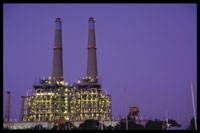Mixed reviews for EPA's NSR program

Controversy is nothing new for the new source review (NSR) program. Since the program's inception in 1977 as part of the Clean Air Act, it has had its share of critics. Ironically, the goal of this preconstruction permitting program seems to be noncontroversial enough — to cut air pollution by requiring companies that upgrade facilities, either by building a new plant or making major modifications to an existing plant, to install effective pollution control equipment. Through the years, however, the U.S. Environmental Protection Agency (EPA), local and state governments, regulated industries, environmental groups and others have continually disagreed about how to make the program fairer and more efficient. Now EPA's recent enforcement actions against coal-fired power plants are creating a new storm of contention.
A look at the structure of the permitting program helps to explain some of the reasons for the ongoing friction. The NSR program for major sources has two different components — one for areas where the air is classified as nonattainment due to the presence of a certain level of pollution and the other for areas where the air quality is better and classified as attainment areas.
A major difference in the two programs is the requried level of control technology. The requirement is stricter and more expensive in the nonattainment areas, calling for the lowest achievable emission rate (LAER). In contrast, the sources located in attainment areas must apply best available control technology (BACT), with the statute allowing consideration of cost in a source's selection of a BACT option.
Some critics of the NSR program argue that it needs to cover more sources and be more stringent, while others feel that the existing program is already too rigorous, time-consurming and broad in scope. Besides these longstanding complaints, EPA is now being attacked for its judicial and administrative enforcement actions brought in November 1999 and March 2000 against a number of electric utilities. EPA alleges that these companies not only made major repairs and modifications to older plants that resulted in increased emissions but also failed to install the proper pollution control equipment. The agency argues that the increases triggered NSR provisions.
These enforcement actions prompted the House Government Reform Subcommittee on National Economic Growth, Natural Resources and Regulatory Affairs to submit questions to EPA in February 2000 seeking answers about the agency's reasons and motivations behind the enforcement actions. Rep. David McIntosh (R-Ind.), the subcommittee chairman, stated in the letter presented to EPA that he is concerned "that EPA's actions may be motivated by what might be called the 'Kyoto agenda' — an ideological animus against coal."
At a U.S. Senate field hearing held on Feb.28, 2000, pertaining to the possible direction of NSR regulatory reforms, several groups complained about EPA's handling of the NSR program. Henson Moore, chief executive officer of the American Forest & Paper Association, said that EPA is violating congressional intent by retroactively altering the NSR program requirements and imposing large fines based on ever-changing interpretations of the rules.
In contrast, at the same hearing David G. Hawkins, director of air and energy programs for the Natural Resource Defense Council, criticized EPA for allowing older power plants that fell under the jurisdiction of the Clean Air Act in the 1970s to be exempted from installing new air pollution control equipment. According to Hawkins, current NSR regulations have allowed utilities "to fly under the radar of EPA" by unjustly extending the life of grandfathered power plants.
In the midst of the fallout from its recent enforcement actions, EPA is undertaking the reform of the NSR program to address many of these concerns. EPA's fundamental principle is to promote more flexibility and certainty in the permitting process, while maintaining a high level of environmental protection.
John Seitz, director of EPA's office of air quality planning and standards, stated in February that EPA is considering the following approaches: the promotion of flexible plantwide caps that would enable sources to make changes at their plants without triggering NSR applicability so long as the overall cap is not exceeded; a more clearly defined and faster process for making control technology decisions; deregulation of source modifications that have recently installed good controls; increased incentives for new or modified sources to incorporate pollution prevention or innovative control technology; and opportunities for more meaningful participation in the permitting process for the public and federal land managers. The agency is also looking into a final NSR base rule and an alternative, sector-based "off-ramp" approach to reduce emissions from power plants.
EPA intends to issue a final NSR rule package some time this year, which promises to provoke more interesting debates among stakeholders. To follow the developments related to the proposed NSR rules, visit EPA's NSR Web site at www.epa.gov/ttn/nsr.
Your M&A connection
This month we're pleased to launch a new regular column called "Deal watch" (p. 80), which will cover mergers and acquisitions and other business trends in the environmental industry. Our columnist Steve Maxwell is the managing director of TechKNOWLEDGE Strategic Group in Boulder, Colo.. He has extensive experience helping environmental service firms develop growth strategies and negotiate mergers and acquisitions.
This article appeared in Environmental Protection, Vol. 11, Number 6, June 2000, Page 6.